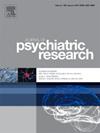甲状腺疾病女性躯体症状障碍的患病率及述情障碍的影响
IF 3.7
2区 医学
Q1 PSYCHIATRY
引用次数: 0
摘要
背景:虽然在甲状腺疾病中,共病性精神病理的高发率是公认的,但对躯体症状障碍(SSD)的患病率和潜在的心理因素却知之甚少。述情障碍是影响慢性疾病主观负担的心理维度之一。本研究旨在探讨女性甲状腺疾病患者的SSD患病率及述情障碍的相关影响。方法通过网络平台招募583名患有甲状腺疾病的成年女性作为方便样本,对其焦虑抑郁(HADS)和述情障碍(TAS-20)进行评估。采用躯体症状量表-8(诊断标准A为ssss -8)、Whiteley指数-7(诊断标准B为WI-7)和6个月病程(诊断标准C)对SSD进行评估。结果SSD患病率为58.7%。SSD受试者的焦虑、抑郁和述情障碍明显高于非SSD受试者。焦虑、TAS-DIF和TAS-DDF正预测ssss -8为31%。医学合并症、TAS-DIF、焦虑和抑郁正预测WI-7,占方差的33%。局限性横断面研究,自我报告评估,社会期望,在线调查。结论:鉴于SSD的高患病率,鼓励临床医生使用筛查程序来评估甲状腺疾病患者的情绪困扰以及潜在的心理因素,如述情障碍。本文章由计算机程序翻译,如有差异,请以英文原文为准。
Prevalence of somatic symptom disorder and influence of alexithymia in women with thyroid diseases
Background
Although the high prevalence of comorbid psychopathology is well acknowledged in thyroid disease, less is known about the prevalence of somatic symptom disorder (SSD) and underlying psychological factors. Alexithymia is one of the psychological dimensions that has shown to affect the subjective burden of chronic diseases. The purpose of this study was to investigate the prevalence of SSD and the related influence of alexithymia in female patients with thyroid diseases.
Methods
A convenience sample of 583 adult women with thyroid diseases was recruited through online platforms and assessed for anxiety and depression (HADS) and alexithymia (TAS-20). SSD was evaluated with the Somatic Symptom Scale-8 (SSS-8 for criterion A) and the Whiteley Index-7 (WI-7 for criterion B) and >6 months disease duration (for criterion C).
Results
The prevalence of SSD was 58.7%. SSD subjects had significantly higher anxiety, depression, and alexithymia than those without SSD. SSS-8 was positively predicted by anxiety, TAS-DIF, and TAS-DDF at 31%. WI-7 was found to be positively predicted by medical comorbidity, TAS-DIF, anxiety, and depression, accounting for 33% of the variance.
Limitations
Cross-sectional study, self-reported assessment, social desirability, online survey.
Conclusions
Given the high prevalence of SSD, clinicians are encouraged to use screening procedures for assessing patients with thyroid diseases for emotional distress as well as underlying psychological factors such as alexithymia.
求助全文
通过发布文献求助,成功后即可免费获取论文全文。
去求助
来源期刊

Journal of psychiatric research
医学-精神病学
CiteScore
7.30
自引率
2.10%
发文量
622
审稿时长
130 days
期刊介绍:
Founded in 1961 to report on the latest work in psychiatry and cognate disciplines, the Journal of Psychiatric Research is dedicated to innovative and timely studies of four important areas of research:
(1) clinical studies of all disciplines relating to psychiatric illness, as well as normal human behaviour, including biochemical, physiological, genetic, environmental, social, psychological and epidemiological factors;
(2) basic studies pertaining to psychiatry in such fields as neuropsychopharmacology, neuroendocrinology, electrophysiology, genetics, experimental psychology and epidemiology;
(3) the growing application of clinical laboratory techniques in psychiatry, including imagery and spectroscopy of the brain, molecular biology and computer sciences;
 求助内容:
求助内容: 应助结果提醒方式:
应助结果提醒方式:


